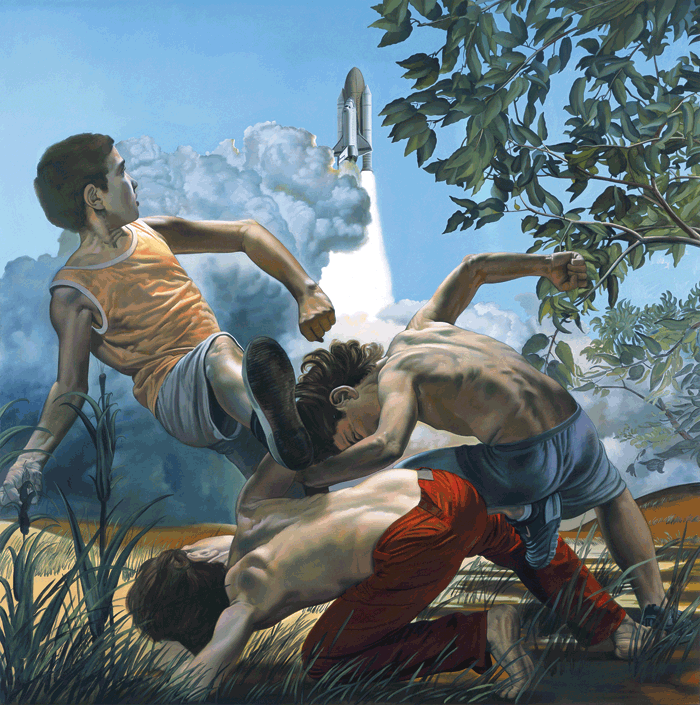« Features
‘The Contemporary’ Or, Just Another Buzzword from Western Academia?
There was a time when ‘modern’ (without the superfluous article) was more contemporary than ‘contemporary’. Think of Alfred Barr, Jr.’s indefatigable crusade for the modern in his essay “Modern Art Makes History, Too” published in 1941 in the College Art Journal. Now it seems that ‘the contemporary’ is the new modern. This idea of updatedness sounds like hard-core modernism.
Since the end of the 1990s, ‘the contemporary’ and its periodization has been one of the key topics in Western academia. Any article, essay, book, panel or even exhibition worth noticing had to exhibit ‘contemporary’ in its title.
It gained critical momentum around 2009 with OCTOBER’s questionnaire on “The Contemporary” published in that year’s fall issue. It also coincided with Terry Smith’s What is Contemporary Art?, The Contemporary Art Book by Charlotte Bonham-Carter and David Hodge, and Alexander Alberro’s lecture “Periodizing Contemporary Art” presented at the Los Angeles Museum of Contemporary Art (LACMA) on February 4, 2009. But even more recent in time we find e.g., What Was Contemporary Art? (2013) by Richard Meyer, Talking Contemporary Curating (2015) by Terry Smith, and Documents of Contemporary Art: Practice (2018) edited by Marcus Boon and Gabriel Levine, that belongs to the famous series of “Documents on Contemporary Art” started by Whitechapel Gallery and MIT back in 2006.

Nicola Verlato, The Anthropic Principle, 2003, 59” x 59.” Courtesy of the artist and Gallery Poulsen, Copenhagen.
The list could easily fill this whole ARTPULSE issue. But to utter ‘the contemporary’ or ‘contemporary’ is, to be honest, like saying Terry Smith, as he has been one of the most ardent and persistent promoters of the concept. I will address his theoretical thinking to see if ‘the contemporary’ is able to articulate the tension between artistic and cultural practices, and our present-day society whose spheres are totally dominated by corporations. I have to admit that I am totally unmotivated by this discussion, and I hope to articulate my indolence.
For Terry Smith, the sequence of historicization is Modernism-Postmodernism-Contemporaneity. Contemporaneity represents, in fact, nothing less than a change of paradigm or a radical break.
“The concept of ‘the contemporary,’”-writes Smith in his OCTOBER1 questionnaire on pages 47 and 48-”far from being singular and simple, a neutral substitute for ‘modern,’ signifies multiple ways of being with, in, and out of time, separately and at once, with others and without them.” It is “shaped by friction between antinomies so intense that it resists generalization” and it responds to “three sets of [contending] forces”: 1) globalization and its thirst for hegemony 2) an accelerated inequality between peoples, classes, and individuals and 3) the total immersion of society in a spectacular image regime (pp. 48-49). Furthermore, with respect to contemporaneity, contemporary art represents an “aesthetic of globalization” that has embraced neoliberal economics that is impulsed by “Retro-sensationalism,” “Remodernism,” and “Spectacularism.” Additionally, Smith insists in that “After the era of grand narratives, they [the multiplicities of contemporary being] may be all that there is.”
Now, this idea of ‘presentism’ or inability of framing our current historical condition is rightly anachronistic: it is a paternalistic way of looking at the past and considers that its subjects were not subjected to the same destabilizing and unsettling forces of transformation as us. I suppose that for somebody in the Middle Ages who thought the earth was flat, finding out that you didn’t fall off the edge must have been a massive shock! The antinomies of globalization, hegemony, and inequality are proper of neo-liberalism and we have been living with them on and off since Reagan and Thatcher got into office in the 1980s. Equally, elements like Retro-sensationalism, Remodernism, and Spectacularism are inherent to postmodernism, maybe more punctuated now due to the actual state of emergency of neoliberalism. In short, most key elements Smith suggests are proper of postmodernism.
Contemporaneity is not the successor of postmodernism or postmodernity. If you want to historicize today’s epoch, neo-modernity would be a more apt definition in line with neoliberalism, because we are just in a new phase of Western modernity linked to globalization.
Finally, I wish Western intellectuals would stop quoting as an incontestable mantra the naïf idea of the “end of grand narratives.” This widespread uncritical repetition doesn’t make academics look good when even Jean-François Lyotard admitted in 1993 in The Postmodern Explained: Correspondence 1982-1985: “In 1979, I linked it [postmodernism] to the problem of the grand narratives with the evident intention of simplifying it-but more than was necessary.” How can you talk about the end of grand narratives when the bourgeois liberal grand narrative in its new mutation of neoliberalism is more alive and kicking than ever and without any other competing grand narrative? How can you talk about the end of grand narratives when nationalisms and religions are stirring the planet?
The contemporary is a mere buzzword by Western Academia that underscores a certain esprit de corps and secures its art-educational complex than an articulated concept capable of triggering discussions with the field of the political, the social and the economic. It’s a bit like Nicola Verlato’s painting: the boys in the foreground pecking at mere trifles while in the back the first Mars mission is being launched!
NOTES
1. Smith, Terry. “What is Contemporary?” OCTOBER 130, fall 2009, pp. 3-124. Cambridge MA: OCTOBER Magazine Ltd. and Massachusetts Institute of Technology, 2009.
Paco Barragán is a PhD candidate at the University of Salamanca (USAL) in Spain and the former visual arts curator of Centro Cultural Matucana 100 in Santiago, Chile. He recently curated “Juan Dávila: Painting and Ambiguity” (MUSAC, 2018), “Arturo Duclos: Utopia´s Ghost” (MAVI, 2017) and “Militant Nostalgia” (Toronto, 2016). He is the author of The Art to Come (Subastas Siglo XXI, 2002) and The Art Fair Age (CHARTA, 2008).




































Leave a Reply
You must be logged in to post a comment.